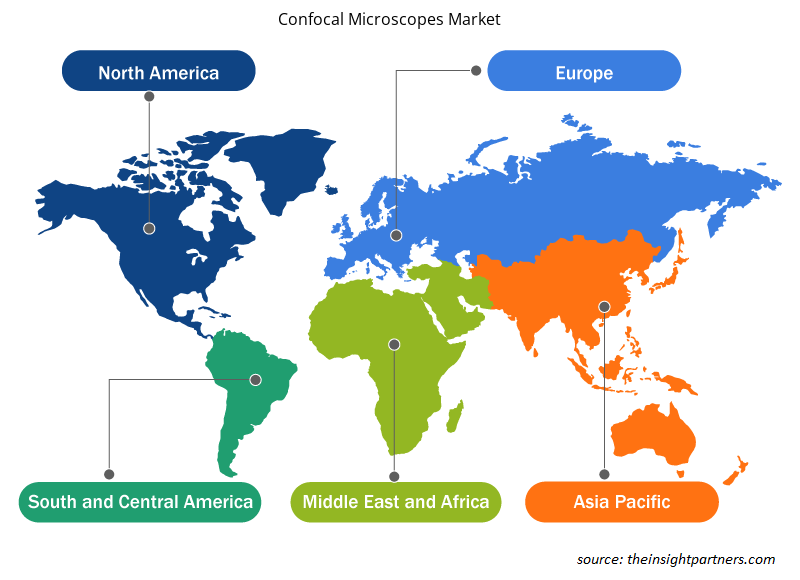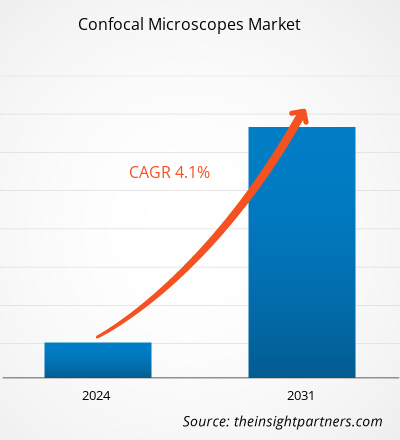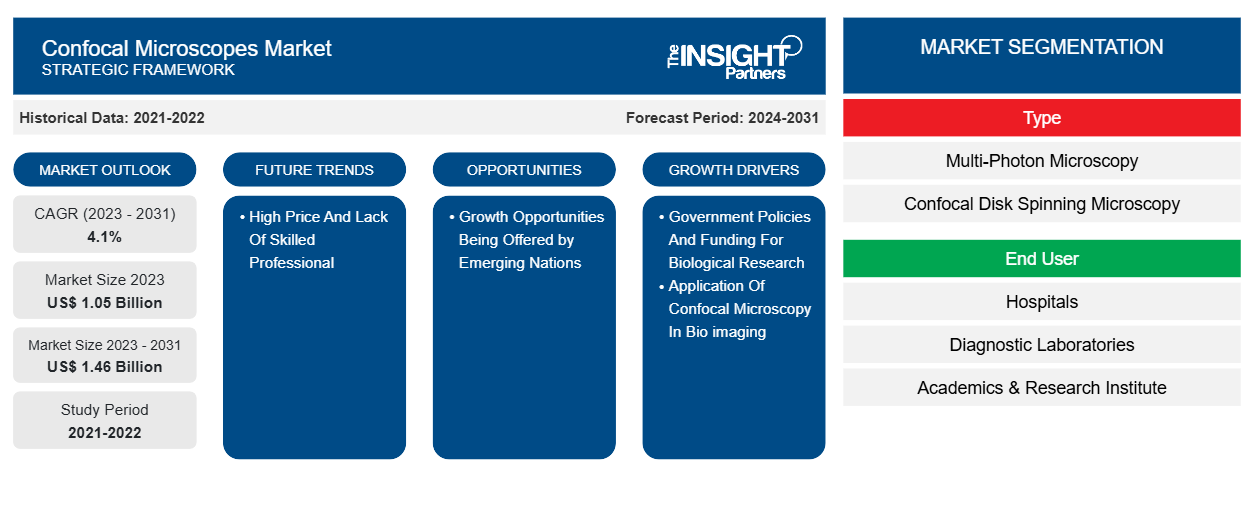La taille du marché des microscopes confocaux devrait atteindre 1,46 milliard de dollars américains d'ici 2031, contre 1,05 milliard de dollars américains en 2023. Le marché devrait enregistrer un TCAC de 4,1 % au cours de la période 2023-2031. Le développement croissant des techniques avancées et la concentration des acteurs dans les pays émergents devraient rester des tendances clés du marché.
Analyse du marché des microscopes confocaux
Les microscopes confocaux sont souvent utilisés pour illustrer clairement la structure exhaustive d'objets spécifiques au sein de la cellule. Les images confocales sont très importantes et utiles pour identifier la contribution de diverses formes de structures sous-nucléaires et anticiper la rigidité nucléaire de plusieurs noyaux à l'échelle mondiale sur la base de protocoles simples d'isolement nucléaire. L'efficacité croissante des microscopes dans les sciences de la vie et la biotechnologie à des fins de recherche sur la structure cellulaire devrait stimuler la croissance du marché au cours de la période de prévision. En outre, la croissance des projets de recherche biologique et des financements associés, les politiques gouvernementales favorables et le grand nombre d'applications de la microscopie confocale dans le domaine de la bioimagerie stimulent le marché. Cependant, le prix élevé et le besoin de personnel qualifié pour manipuler les microscopes confocaux pourraient ralentir la croissance du marché.
Aperçu du marché des microscopes confocaux
La microscopie confocale offre plusieurs avantages par rapport aux méthodologies traditionnelles, notamment la possibilité de contrôler la profondeur de champ, d'éliminer ou de réduire les détails d'arrière-plan du plan focal (conduisant à une dégradation de l'image) et de collecter des sections optiques en série à partir d'échantillons épais. Le besoin croissant de microscopes confocals est dû aux diverses activités de recherche et développement dans de nombreux secteurs tels que les neurosciences, la science des matériaux et les sciences de la vie. Les améliorations quotidiennes des technologies d'imagerie, telles que l'amélioration de la sensibilité et de la résolution, ainsi que des vitesses d'imagerie, devraient également favoriser l'acceptation des microscopes confocals, stimulant ainsi la croissance du marché. En outre, de plus en plus de chercheurs recherchent également des outils de pointe qui amélioreraient les capacités d'imagerie, ce qui offrirait à son tour des opportunités de croissance pour le marché.
Personnalisez ce rapport en fonction de vos besoins
Vous bénéficierez d'une personnalisation gratuite de n'importe quel rapport, y compris de certaines parties de ce rapport, d'une analyse au niveau des pays, d'un pack de données Excel, ainsi que de superbes offres et réductions pour les start-ups et les universités.
-
Obtenez les principales tendances clés du marché de ce rapport.Cet échantillon GRATUIT comprendra une analyse de données, allant des tendances du marché aux estimations et prévisions.
Facteurs moteurs et opportunités du marché des microscopes confocaux
Application de la microscopie confocale en bio-imagerie pour favoriser le marché
La microscopie confocale trouve une application considérable dans le domaine de la recherche en biologie, comme l'imagerie de cellules vivantes , les études en neurosciences et autres. La microscopie confocale permet l'analyse d'échantillons épais marqués par fluorescence sans sectionnement physique, une plus grande différenciation des couleurs est possible car les images sont visualisées sur le système plutôt qu'à l'œil nu, une reconstruction tridimensionnelle de l'échantillon est possible et une résolution améliorée. Une technique de microscopie confocale a permis à l'équipe de recherche de détecter une cascade de vasodynamique capillaire anormale dans le cerveau. Compte tenu de l'énorme application de la microscopie confocale dans le domaine de la bioimagerie, les acteurs du marché prennent des initiatives stratégiques pour stimuler la croissance du marché.bioimaging the market players are taking strategic initiatives for boosting the market growth.
Les opportunités de croissance offertes par les pays émergents
Le secteur de la santé a connu une évolution rapide au cours des dernières années. Diverses avancées technologiques ont été observées dans des segments tels que la microscopie à fluorescence , les microscopes laser et l'utilisation de la visualisation 3D pour les interventions chirurgicales. D'autres applications du microscope confocal en dermatologie, étude histologique de la muqueuse gastro-intestinale, imagerie de cellules vivantes pour la compréhension de l'échantillon. L'augmentation de l'incidence des maladies chroniques telles que le cancer et le vieillissement de la population sont les principaux facteurs qui alimentent la croissance du secteur de la santé. Pour le développement de produits et de technologies meilleurs et avancés pour le secteur de la santé, divers acteurs du secteur investissent une part importante de leurs revenus dans des activités de recherche et développement. De tels facteurs sont susceptibles d'offrir de fortes opportunités de croissance pour les microscopes confocaux dans le secteur de la santé au niveau mondial.
Analyse de segmentation du rapport sur le marché des microscopes confocaux
Les segments clés qui ont contribué à l’élaboration de l’analyse du marché des microscopes confocals sont le type et l’utilisateur final.
- En fonction du type, le marché des microscopes confocals est divisé en microscopie multiphotonique et microscopie confocale à rotation de disque. Le segment de la microscopie multiphotonique détenait la plus grande part de marché en 2023 et devrait enregistrer le TCAC le plus élevé au cours de la période de prévision.
- En termes d'utilisateur final, le marché est divisé en hôpitaux, instituts universitaires et de recherche, laboratoires de diagnostic. Le segment des instituts universitaires et de recherche détenait la plus grande part du marché en 2023 et devrait enregistrer le TCAC le plus élevé au cours de la période 2021-2031.
Analyse des parts de marché des microscopes confocaux par géographie
La portée géographique du rapport sur le marché des microscopes confocals est principalement divisée en cinq régions : Amérique du Nord, Asie-Pacifique, Europe, Moyen-Orient et Afrique, et Amérique du Sud et centrale.
L'Amérique du Nord a dominé le marché des microscopes confocaux. Les facteurs conduisant à la croissance du marché des microscopes confocaux en Amérique du Nord sont l'augmentation de la prévalence des maladies chroniques et des troubles oculaires dans la région. En outre, la précision offerte par les microscopes confocaux dans la détection précise de ces maladies devrait alimenter la demande au cours de la période de prévision. Les États-Unis ont une prévalence importante de maladies chroniques en raison de divers facteurs tels que des niveaux de vie inadéquats, l'urbanisation ainsi que la toxicomanie, entre autres. Le cancer de la peau est l'une des formes de cancer les plus courantes aux États-Unis. Par conséquent, les avantages offerts par la microscopie confocale pour la détection du cancer ainsi que le soutien des organismes gouvernementaux devraient stimuler le marché des microscopes confocaux au cours des prochaines années.
Aperçu régional du marché des microscopes confocaux
Les tendances et facteurs régionaux influençant le marché des microscopes confocaux tout au long de la période de prévision ont été expliqués en détail par les analystes d’Insight Partners. Cette section traite également des segments et de la géographie du marché des microscopes confocaux en Amérique du Nord, en Europe, en Asie-Pacifique, au Moyen-Orient et en Afrique, ainsi qu’en Amérique du Sud et en Amérique centrale.

- Obtenez les données régionales spécifiques au marché des microscopes confocaux
Portée du rapport sur le marché des microscopes confocaux
| Attribut de rapport | Détails |
|---|---|
| Taille du marché en 2023 | 1,05 milliard de dollars américains |
| Taille du marché d'ici 2031 | 1,46 milliard de dollars américains |
| Taux de croissance annuel composé mondial (2023-2031) | 4,1% |
| Données historiques | 2021-2022 |
| Période de prévision | 2024-2031 |
| Segments couverts |
Par type
|
| Régions et pays couverts |
Amérique du Nord
|
| Leaders du marché et profils d'entreprises clés |
|
Densité des acteurs du marché : comprendre son impact sur la dynamique des entreprises
Le marché des microscopes confocaux connaît une croissance rapide, tirée par la demande croissante des utilisateurs finaux en raison de facteurs tels que l'évolution des préférences des consommateurs, les avancées technologiques et une plus grande sensibilisation aux avantages du produit. À mesure que la demande augmente, les entreprises élargissent leurs offres, innovent pour répondre aux besoins des consommateurs et capitalisent sur les tendances émergentes, ce qui alimente davantage la croissance du marché.
La densité des acteurs du marché fait référence à la répartition des entreprises ou des sociétés opérant sur un marché ou un secteur particulier. Elle indique le nombre de concurrents (acteurs du marché) présents sur un marché donné par rapport à sa taille ou à sa valeur marchande totale.
Les principales entreprises opérant sur le marché des microscopes confocaux sont :
- Société Olympus
- Microsystèmes Leica
- Sociétés Nikon
- Carl Zeiss SA
- Bruker
- Société Keyence
Avis de non-responsabilité : les sociétés répertoriées ci-dessus ne sont pas classées dans un ordre particulier.

- Obtenez un aperçu des principaux acteurs du marché des microscopes confocaux
Actualités et développements récents du marché des microscopes confocaux
Le marché des microscopes confocaux est évalué en collectant des données qualitatives et quantitatives après des recherches primaires et secondaires, qui comprennent d'importantes publications d'entreprise, des données d'association et des bases de données. Quelques-uns des développements du marché des microscopes confocaux sont répertoriés ci-dessous :
- Leica Microsystems a annoncé une nouvelle collaboration passionnante avec le département de biochimie de l'université d'Oxford au Royaume-Uni, dans les domaines de la microscopie optique et à super résolution, de l'intelligence artificielle, de la microscopie corrélative et de la préparation d'échantillons EM. Le centre d'excellence sera hébergé par l'installation de bioimagerie Micron de classe mondiale au sein du département de biochimie de l'université d'Oxford et présentera des solutions d'imagerie de pointe de Leica Microsystems, telles que la plate-forme de microscope confocal STELLARIS 5 et Mica Microhub. (Leica Microsystems, News, septembre 2023)
- Nikon Instruments Inc. a annoncé la sortie du microscope confocal multiphotonique à super-résolution AX R MP avec NSPARC, qui permet une détection de matrice extrêmement sensible et une super-résolution dans les zones profondes au sein de grands spécimens d'organismes vivants. Ce produit contribuera à la compréhension des maladies cérébrales telles que la maladie d'Alzheimer et la maladie de Parkinson, ainsi qu'à la recherche sur la découverte de médicaments. (Nikon Instruments Inc., News, juillet 2023)
- Discover Echo, une société BICO et l'un des principaux fournisseurs de technologies innovantes de microscopie et d'imagerie, a lancé son dernier produit : le microscope confocal Echo, un système d'imagerie avancé fournissant des images haute résolution d'échantillons biologiques avec une clarté et des détails exceptionnels. Ce produit ouvre la porte à un tout nouveau marché mondial pour Discover Echo, car l'Echo Confocal apportera une facilité d'utilisation et une accessibilité inégalées. Le microscope confocal Echo est conçu pour être facile à utiliser et doté d'une gamme de fonctions automatisées pour simplifier l'acquisition d'images. Son interface utilisateur intuitive unique facilite son utilisation par les chercheurs de tous niveaux de compétence, tandis que sa conception compacte lui permet de s'intégrer facilement dans n'importe quel environnement de laboratoire. (BICO, communiqué de presse, février 2023)
- Nikon Instruments Inc. a annoncé le détecteur confocal Nikon Spatial Array (NSPARC) pour les systèmes AX. Le système de détecteur confocal nouvellement développé utilise un réseau de détecteurs à très faible bruit pour la collecte de données confocales à balayage ponctuel, améliorant le rapport signal/bruit et permettant ainsi l'imagerie à une puissance d'excitation plus faible. Cela permet une imagerie haute résolution de tissus vivants avec une phototoxicité minimale. Prévu pour une sortie début février 2023, ce produit sera utilisé en combinaison avec les microscopes confocals AX ou AX R. (Nikon Instruments Inc., News, février 2023)
Rapport sur le marché des microscopes confocaux : couverture et livrables
Le rapport « Taille et prévisions du marché des microscopes confocaux (2021-2031) » fournit une analyse détaillée du marché couvrant les domaines ci-dessous :
- Taille et prévisions du marché des microscopes confocals aux niveaux mondial, régional et national pour tous les segments de marché clés couverts par le champ d'application
- Tendances du marché des microscopes confocals ainsi que la dynamique du marché telles que les moteurs, les contraintes et les opportunités clés
- Analyse PEST et SWOT détaillée
- Analyse du marché des microscopes confocals couvrant les principales tendances du marché, le cadre mondial et régional, les principaux acteurs, les réglementations et les développements récents du marché
- Analyse du paysage industriel et de la concurrence couvrant la concentration du marché, l'analyse de la carte thermique, les principaux acteurs et les développements récents pour le marché des microscopes confocaux
- Profils d'entreprise détaillés
- Analyse historique (2 ans), année de base, prévision (7 ans) avec TCAC
- Analyse PEST et SWOT
- Taille du marché Valeur / Volume - Mondial, Régional, Pays
- Industrie et paysage concurrentiel
- Ensemble de données Excel
Rapports récents
Rapports connexes
Témoignages
Raison d'acheter
- Prise de décision éclairée
- Compréhension de la dynamique du marché
- Analyse concurrentielle
- Connaissances clients
- Prévisions de marché
- Atténuation des risques
- Planification stratégique
- Justification des investissements
- Identification des marchés émergents
- Amélioration des stratégies marketing
- Amélioration de l'efficacité opérationnelle
- Alignement sur les tendances réglementaires























 Obtenez un échantillon gratuit pour - Marché des microscopes confocaux
Obtenez un échantillon gratuit pour - Marché des microscopes confocaux